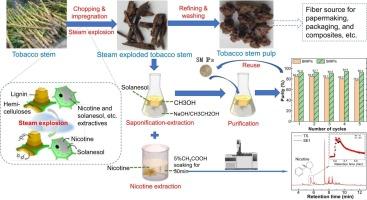烟茎蒸汽爆破处理的优化,以提高茄尼醇和尼古丁的提取
IF 6.2
1区 农林科学
Q1 AGRICULTURAL ENGINEERING
引用次数: 0
摘要
在这项研究中,利用瞬时弹射蒸汽爆炸(ICSE)技术对废烟草茎进行碎片化,并增强茄尼醇和尼古丁这两种感兴趣的生物活性化合物的增溶作用。经统计学分析,ICSE压力(P = 0.043)和碱用量(P = 0.035)与茄尼醇产率有显著相关。在SE3参数(压力0.8 MPa,维持时间9 min,碱用量5 %)下,获得了茄尼醇的最佳提取条件,得率为0.408 mg/g,提取率为99.03 %。为了纯化茄尼醇,采用了两种类型的分子印迹聚合物(MIPs):表面分子印迹聚合物(smip)和大块分子印迹聚合物(BMIPs)。反相乳液聚合法制备的smip具有优异的工业应用性能。这些smip在5个重复使用周期后仍保持其净化能力,证明了它们的鲁棒性和稳定性。对于烟碱,在SE1条件下(压力0.8 MPa,维持时间5 min,不加碱)得率最高,为0.8 mg/g,提取率为72.7 %。通过对抽提率的比较分析表明,尼古丁可能是通过ICSE卸压阶段释放的蒸汽直接冷凝而被浓缩的。假设蒸汽凝结对烟碱浓度起关键作用,SE6条件(压力1.0 MPa,维持时间9 min,碱用量0 %)最有利。理论计算表明,在此条件下,得率为0.9 mg/g,提取率为81.8 %。本研究介绍了一种从废烟草茎中提取和纯化生物活性化合物的新方法。它强调了农业副产品可持续利用的潜力,并推动了绿色化学过程的发展。本文章由计算机程序翻译,如有差异,请以英文原文为准。

Optimized steam explosion treatment of tobacco stems for enhanced extraction of solanesol and nicotine
In this research, the Instantaneous Catapult Steam Explosion (ICSE) technique was utilized to fragment waste tobacco stems and enhance the solubilization of solanesol and nicotine, two bioactive compounds of interest. Statistical analysis revealed significant correlations between ICSE pressure (P = 0.043) and alkali dosage (P = 0.035) with solanesol yield. The optimal conditions for solanesol extraction were achieved under SE3 parameters (pressure 0.8 MPa, maintenance time 9 min, alkali dosage 5 %), resulting in a yield of 0.408 mg/g and an extraction rate of 99.03 %. To purify solanesol, two types of molecularly imprinted polymers (MIPs) were employed: Surface molecularly imprinted polymers (SMIPs) and bulk molecularly imprinted polymers (BMIPs). The SMIPs prepared through inverse emulsion polymerization exhibited superior performance for industrial-scale applications. These SMIPs retained their purification capacity after five reuse cycles, demonstrating their robustness and stability. For nicotine, the highest yield was obtained under SE1 conditions (pressure 0.8 MPa, maintenance time 5 min, and no alkali dosage), yielding 0.8 mg/g with an extraction rate of 72.7 %. Comparative analysis of the extraction rates indicates that nicotine might be concentrated through the direct condensation of vapors released during the ICSE pressure relief phase. Under the hypothesis that vapor condensation plays a critical role in nicotine concentration, the SE6 condition (pressure 1.0 MPa, maintenance time 9 min, alkali dosage 0 %) was the most favorable. Theoretical calculations suggest a yield of 0.9 mg/g and an extraction rate of 81.8 % under these conditions. This study introduces a novel and efficient approach for the extraction and purification of bioactive compounds from waste tobacco stems. It highlights the potential for sustainable utilization of agricultural by-products and advances the development of green chemistry processes.
求助全文
通过发布文献求助,成功后即可免费获取论文全文。
去求助
来源期刊

Industrial Crops and Products
农林科学-农业工程
CiteScore
9.50
自引率
8.50%
发文量
1518
审稿时长
43 days
期刊介绍:
Industrial Crops and Products is an International Journal publishing academic and industrial research on industrial (defined as non-food/non-feed) crops and products. Papers concern both crop-oriented and bio-based materials from crops-oriented research, and should be of interest to an international audience, hypothesis driven, and where comparisons are made statistics performed.
 求助内容:
求助内容: 应助结果提醒方式:
应助结果提醒方式:


